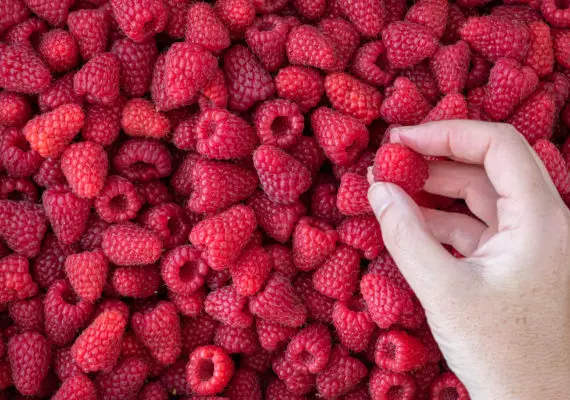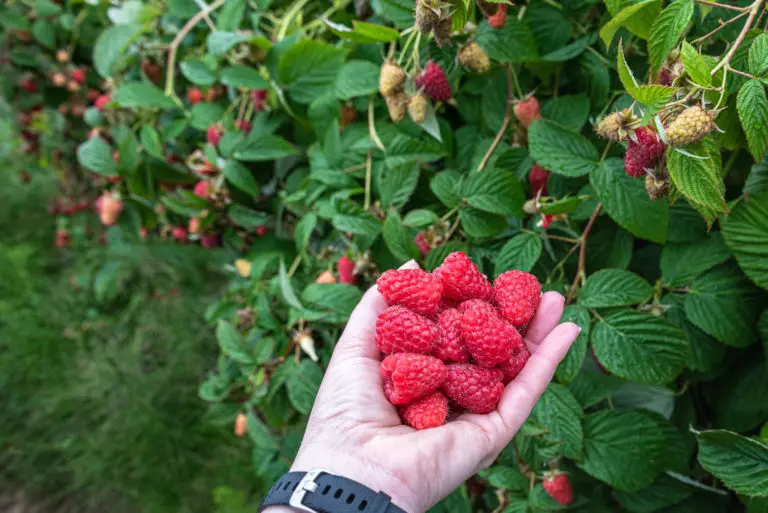
WHAT ARE THE REQUIREMENTS FOR RASPBERRIES AND DO THEY LIKE LIMING?
Raspberry bushes require soil with a neutral character ranging from pH 6.2 to 6.7. This pH range is optimal for soil acidity in which these plants grow best. Raspberries thrive in soil with a high content of organic matter, which will retain water and nitrogen. This enables raspberries to develop strong vegetative shoots. Before applying any fertilizers, soil samples should be taken and analyzed. Only through this process can you be sure of the nutrients the plants need and in what quantities. For proper growth, raspberries require elements such as nitrogen, phosphorus, potassium, magnesium, and calcium.
A good solution to provide many nutrients for raspberries is to fertilize the raspberry plantation with manure. This will supply most of the necessary nutrients to the plants. Lime application to raspberries should not be forgotten. This procedure will adjust the soil to the appropriate pH level when it is too acidic. The best solution for existing raspberry plantations is to use granulated lime, such as Polcalc III Generation, every year. The dosage should be around 500-600 kg per hectare. If the soil is deficient in magnesium, magnesium lime SuperMag can be applied at a dosage of 500-1000 kg per hectare. Both fertilizers, as well as their precise dosage – depending on the soil pH, can be found on the website https://polcalc.pl/.
WHAT ELEMENTS MUST THE SOIL BE RICH IN FOR RASPBERRY CULTIVATION?
Depending on the results of the soil analysis, potassium, phosphorus, and nitrogen deficiencies can be supplemented. Raspberries require the following amounts of these elements: potassium from 80 to 120 kg per hectare, phosphorus from 40 to 70 kg per hectare, and nitrogen from 42 to 122 kg per hectare.
Nitrogen promotes raspberry growth and also enhances fruit size and firmness. It prevents raspberry shoot dieback and aids in the absorption of other elements from the soil, such as calcium, potassium, and magnesium.
Phosphorus helps young raspberries develop a proper root system and improves their establishment. It positively affects fruit size, color, and firmness. It is essential to maintain the soil at the proper level because, at a pH lower than 5.5, phosphorus becomes unavailable to raspberries.
Potassium increases raspberry plantation yields and prevents plant frost damage during winter. It is important to remember that raspberries do not tolerate chlorine, so potassium fertilization should be based on chloride-free fertilizers.
Additionally, magnesium and calcium are necessary. Magnesium prevents the occurrence of marble chlorosis, which can develop into necrosis. It is important to maintain the proper ratio between potassium and magnesium fertilization, which should be 3 to 1. This prevents potassium deficiency resulting from excessive magnesium doses.
Calcium is a crucial element for raspberries, so it is necessary to lime the raspberry plantation. Calcium is responsible for water, protein, and carbohydrate metabolism in raspberries. Thanks to calcium, the fruits are firm, and sweet, have an adequate amount of vitamin C, and are healthy and well-shaped.
HOW TO PLANT RASPBERRIES? HOW TO LIME?
It is important to obtain high-quality seedlings from a reliable source. However, before establishing raspberry plantations, the soil must be prepared first. It is necessary to conduct a soil test – a chemical analysis. It is best to start this process a year before planting the first raspberry seedlings. This way, you can properly fertilize the soil with doses of fertilizers suitable for the soil test results.
When preparing the soil for raspberry cultivation, it is advisable to lime the soil. For this purpose, Kujawit or Kujawit Premium lime can be used. It works particularly well on light soils. The maximum dose is 3.5 t per hectare. If the soil test results indicate the need to also increase the magnesium level in the soil, magnesium lime, such as Radkowit or Radkowit Premium, will work well, at a maximum dose of up to 4.5 t per hectare. Typically, these doses range from 500 to 2500 kg per hectare. Precise fertilization dosages depending on the type and chemical composition of the soil can be found on the website https://polcalc.pl/.

Liming should be done every year in early spring or late autumn. Spring liming, for example, using the Polcalc III Generation or SuperMag preparation, is carried out when the surface layer of the soil has thawed, and raspberry bushes have not yet formed leaves. Autumn liming, on the other hand, is done after harvesting the fruits from late October to mid-November.
Raspberries grow best in wind-sheltered locations, in semi-shade. They do not tolerate root drying, so they should be planted very quickly after purchase. Alternatively, they can be placed in a temporary hole. Raspberries should be planted in rows every 1.5 m, and the distance between plants should be 40 cm.
The hole for planting raspberries should be 25 cm deep and 60 cm wide. It is best to plant raspberries in autumn from September to November, as well as in early spring. Raspberries planted in spring will have lower fruiting in the first year of cultivation.






